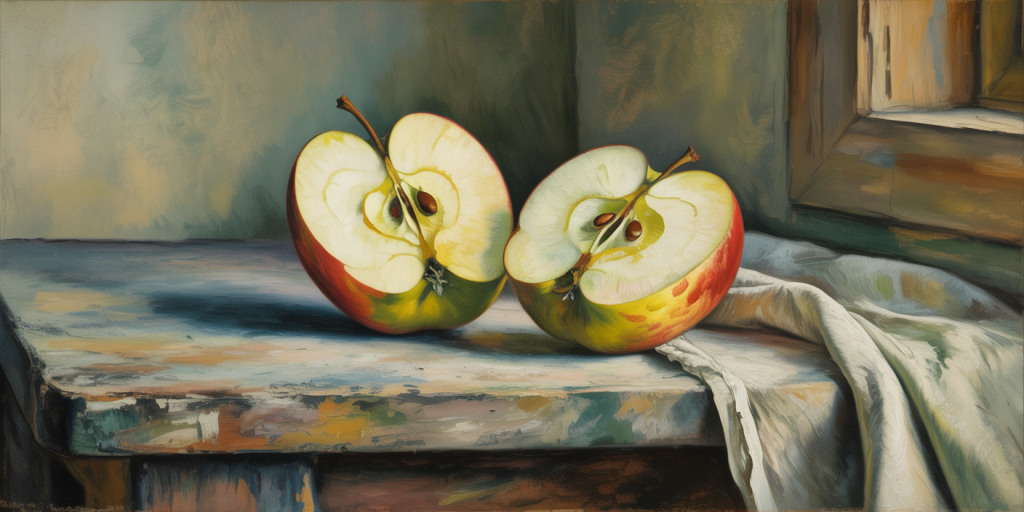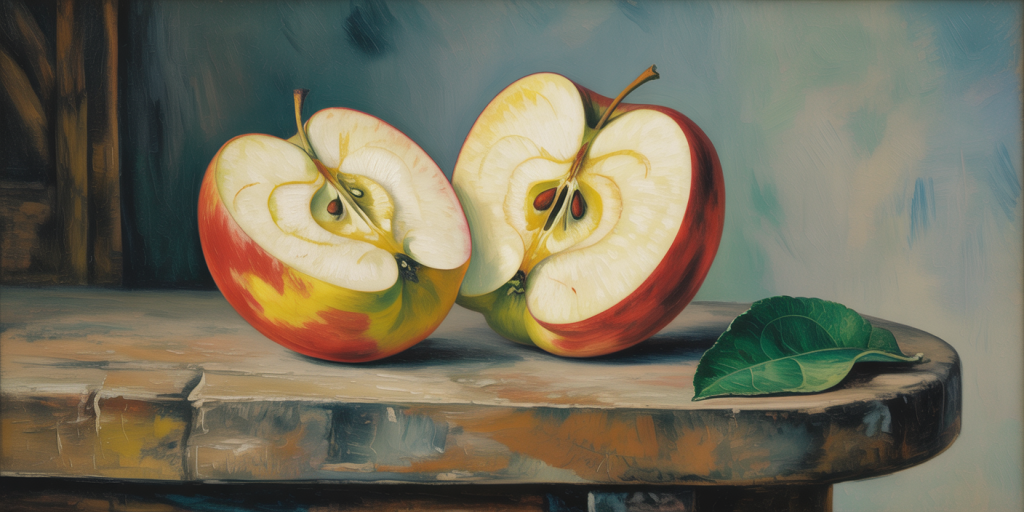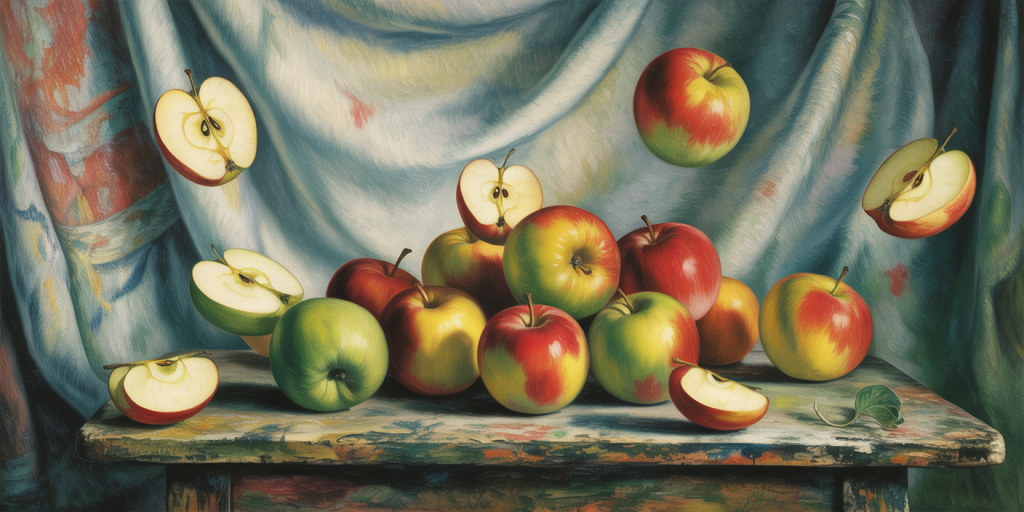The Split Apple of Cézanne and the Universe Torn Open
In a stillness that hums with ancestral echoes, Paul Cézanne placed before us not a fruit, but a world — halved. The cut apple rests gently on its surface, but carries the weight of creation, like a celestial womb revealing its sacred rupture. There is something unsettlingly tender in its presence, as if it remembers the first bite, the fall, and the endless search for wholeness.
His apple does not decay. It does not shine. It pulses. Cézanne does not simply paint — he listens to matter and measures its murmur. Within the soft incision of this apple lies a cartography of the unknowable: a dream-space where texture is memory, and color is the sound of thought.
Table of Contents
- Where the Skin Breaks, the Soul Emerges
- A Geometry of Desire
- Fruit as Fossil of the Interior Life
- The Silence Between Colors
- Planes of Thought and Apple Flesh
- The Table as a Stage for Intimacy
- Crimson Edges and the Echo of Light
- The Tactile Breath of Oil and Canvas
- The Shadow that Carries the Form
- Tension Between the Seen and the Felt
- The Apple as a Wound of Perception
- Stillness in Suspense: Cézanne’s Timeless Pause
- Deconstructing the Simple
- When Color Thinks Itself
- The Mind’s Apple and the Body’s Fruit
- Slicing Memory, Layer by Layer
- A Mythological Core in Modern Skin
- Apples That Remember Eden
- The Painter Who Measured Time with Pigment
- Cézanne and the Sacred Imperfection
Where the Skin Breaks, the Soul Emerges
A single slice through the skin of an apple becomes, in Cézanne’s hand, a philosophical incision. It is a quiet violence — not brutal, but revealing. The fruit becomes less a subject and more a vessel, releasing essence rather than juice. The broken skin is a metaphor for the self: to reveal, one must rupture.
There’s intimacy in this unveiling. The brushstroke hesitates at the edge of the divide, tender and trembling. Cézanne does not render the cut with anatomical precision, but with metaphysical reverence. What lies inside is not biology — it is the substance of thought.
A Geometry of Desire
In the spatial logic of Cézanne, apples are not round — they are spirals of becoming. Their shapes are not fixed but emergent, formed by gaze and longing. The cut apple reveals not only pulp but the curvature of perspective itself.
The viewer’s eye circles the form, tracing ellipses and incomplete arcs. We are not meant to consume the fruit, but to orbit it. It becomes a gravitational center, pulling our perception toward the center of meaning.
Fruit as Fossil of the Interior Life
There is something archaeological about Cézanne’s apple. It feels excavated — not freshly sliced but uncovered from a deeper strata of being. Time adheres to it like dust on an ancient bone.
The pulp glows faintly, not from light but from memory. It is a relic of emotion, preserved in pigment. In the silence of the studio, Cézanne has painted not the object, but the resonance of its presence — the echo left by every apple ever eaten in solitude.
The Silence Between Colors
Cézanne’s palette is quiet, but never mute. Between his ochres and vermilions there exists a hush — a contemplative pause where form dissolves into sensation.
This silence is the key to the apple’s power. Its vibrancy emerges not from saturation but from restraint. Like whispered confessions, his colors lean into one another, touching softly, never shouting.

Planes of Thought and Apple Flesh
Each angle in Cézanne’s still life suggests more than surface — it suggests introspection. He constructs space not with linear perspective, but with emotional vectors. The apple, when halved, becomes not two halves but two ideas.
The juxtaposition of these planes — the smooth skin, the jagged pulp, the bruised contour — is not accidental. They are layered thoughts, stacked like folded linens, each crease a moment of reflection.
The Table as a Stage for Intimacy
On the wooden table, the apple does not simply sit — it performs. It is actor and altar piece, poised in ritual. The table is unadorned, humble, yet becomes a sacred plane upon which Cézanne enacts his silent drama.
There is an eroticism in its stillness — not sexual, but sensory. We feel the warmth of the wood, the cool resistance of the apple’s skin, the soft give of its flesh. The table becomes a bed for revelation.
Crimson Edges and the Echo of Light
Light in Cézanne’s canvas is not illumination — it is memory. It skims across the crimson edge of the apple like breath across bare skin. The highlights are not declarations but sighs.
There is no clear source of light. It emerges from within, or perhaps from the viewer’s own longing. We are not shown the sun, but the soul it touches.
The Tactile Breath of Oil and Canvas
Cézanne’s medium is not paint — it is breath captured in oil. His brushstrokes are not strokes, but murmurs, caresses, confessions. Each mark on the canvas feels like a pulse.
Texture is sacred here. The weave of the canvas shows through like veins beneath the skin. The pigment clings to the surface as memory clings to the body — unevenly, intimately.
The Shadow that Carries the Form
Cézanne’s shadows are not absences — they are counterweights. They do not erase but anchor. Around the apple, shadow pools like ink at the base of a letter, grounding the floating thought.
There is no fear in his darks. They are warm, human, lived-in. In the shadow, the apple becomes real. Its split becomes consequence. Its weight becomes known.
Tension Between the Seen and the Felt
What Cézanne gives us is not vision but perception. We do not merely see the apple — we feel it looking back. There is a tension here, a psychic friction between what is seen and what is meant.
The eye is invited to touch, to probe, to linger. The longer we look, the less we observe and the more we participate. We become part of the fruit’s contemplation.
The Apple as a Wound of Perception
The cut is not innocent. It bleeds metaphor. It suggests rupture — not of flesh alone, but of unity. Something whole has been divided, and in that division, meaning is born.
The apple becomes the body. The incision becomes vulnerability. Cézanne does not bandage it — he frames it. The wound is honored, seen, made permanent in oil.

Stillness in Suspense: Cézanne’s Timeless Pause
Time does not pass in Cézanne’s canvas. It hovers. The apple neither rots nor ripens. It exists in an eternal now, a perpetual moment of before and after.
This stillness is not static — it is suspenseful. It is the breath held before a word, the silence before touch. The apple waits, and in its waiting, it teaches us patience.
Deconstructing the Simple
Cézanne’s genius lies in his refusal to render the apple as mere object. He dissects simplicity, revealing its layered architecture. Each contour becomes question. Each color, an echo.
He returns again and again to the same fruit, like a monk chanting a single syllable of truth. Through repetition, meaning deepens. Through minimalism, infinity emerges.
When Color Thinks Itself
There are moments in the canvas where color ceases to represent and begins to think. The green beside the apple does not suggest a leaf — it suggests contrast. The orange does not describe — it vibrates.
Cézanne teaches us that color has grammar, that hue can whisper, that temperature has tone. His palette is a philosophy — sensual, deliberate, poetic.
The Mind’s Apple and the Body’s Fruit
This apple is a mind-body problem in pigment. It is intellect made edible, body made visible. Cézanne’s gaze does not rest on the surface — it sinks, probes, merges.
We eat the image not with mouth, but with mind. The apple becomes nourishment for perception, feeding our need to comprehend beauty through fracture.
Slicing Memory, Layer by Layer
With every cut, Cézanne slices not only fruit, but memory. Each brushstroke lifts a veil. We recall childhood snacks, biblical myths, afternoon stillness. The apple is mnemonic.
But this is not nostalgia — it is excavation. He is not remembering, but rediscovering. The apple becomes an archetype, carved from our collective mind.
A Mythological Core in Modern Skin
The apple, so rooted in Eden and Eros, becomes in Cézanne’s hand a modern relic. He strips it of allegory, but not of depth. It remains sacred — only now, secular.
It is a fruit of myth, dressed in 19th-century quietude. It is no longer forbidden, yet still charged. The divine resides in the cut, not the commandment.

Apples That Remember Eden
Even in their ordinariness, Cézanne’s apples carry the scent of paradise. They are not literal fruit, but emotional residue. Eden is not a place — it is a longing.
The apple’s divide is not expulsion but invitation. We are not cast out — we are called in, to consider ourselves anew through the lens of form and fracture.
The Painter Who Measured Time with Pigment
Cézanne painted slowly. Obsessively. Lovingly. His apples were not done when beautiful, but when true. He layered pigment like time itself — sedimentary, patient, profound.
Through this temporal labor, he taught us how to see. Not quickly. Not completely. But humbly, and again.
Cézanne and the Sacred Imperfection
In the crooked edges and hesitant contours lies the divine. Cézanne’s apple is never ideal. It is bruised, asymmetrical, flawed — and it is precisely this that makes it sublime.
He paints not perfection, but presence. Not the concept of an apple, but its felt truth. And in that humble fruit, we find the universe split open.
FAQ
Who was Paul Cézanne?
A French post-impressionist painter whose work laid the foundation for modernist approaches in the 20th century. He focused deeply on form, perception, and the geometry of nature.
Why are apples so recurrent in Cézanne’s still lifes?
For Cézanne, apples represented a perfect tension between simplicity and complexity, form and emotion. They allowed endless variations in color, texture, and structure.
What makes Cézanne’s depiction of apples unique?
Rather than depict them realistically, Cézanne used apples as meditative devices to explore space, time, and the nature of seeing.
Is there a symbolic meaning behind the cut apple?
Yes. The incision can suggest fragmentation, vulnerability, perception, and memory. It’s a moment of transformation — an opening, both literal and metaphorical.
Notes from the Table’s Edge
The apple is cut, but the world is not broken. In Cézanne’s stillness, we learn that to slice is not to destroy — it is to reveal. Within that quiet rupture lies the pulse of being.
We do not finish the painting by looking. We finish it by pausing, by feeling, by listening to its silence. And in that silence, we see ourselves — imperfect, tender, whole through our division.
